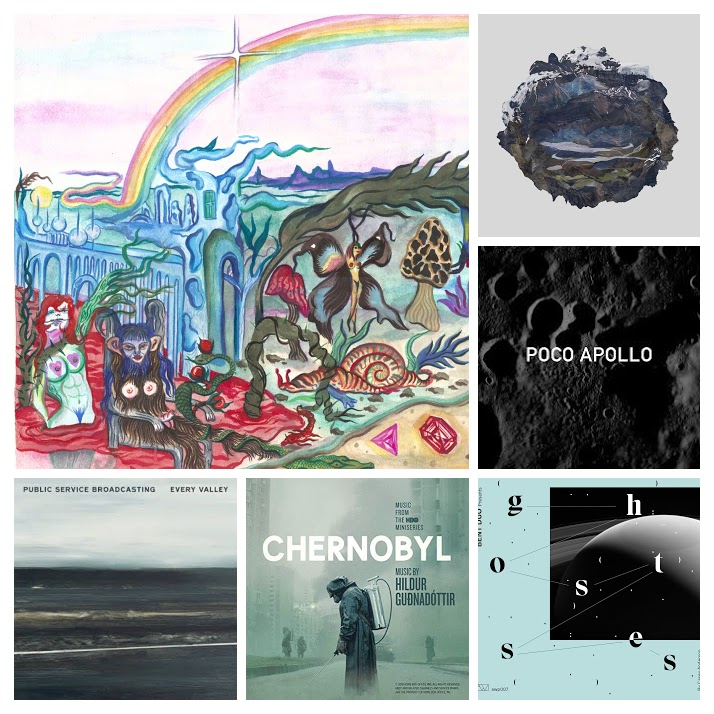
I am fascinated by music whose composition is as much a part of the story as its sound; music that is written according to some sort of formula or experimental process. More often than not, the story of how these pieces of music came into existence is more interesting than the music itself. But I like interesting stories, so I like that this music exists. Even when it’s not particularly listenable.
.
Bent Duo
I will let the Bandcamp Daily explain the process for Bent Duo’s ghostses:
https://daily.bandcamp.com/2019/04/30/best-of-bandcamp-contemporary-classical-april-2019/
This peculiar piece by Los Angeles composer Casey Anderson was developed between 2016–2018 for Bent Duo (keyboardist David Friend and percussionist Bill Solomon). “Ghostses” is a tricky rhythmic system derived from the first chapter of W.G. Sebald’s novel The Rings of Saturn, using the programming language Python. It parses the text into elliptical layers translated onto stacked transparencies, with a sheet of paper containing the full Sebald text at the bottom that the performers read both silently in full (to themselves) and selected words and phrases aloud.
It isn’t exactly easy to listen to, and I can’t even imagine just putting it on like a normal album. But I love the way it’s as much experimental poetry performance as composition, and it’s not unrewarding as an active listening experience.
.
Hafdis Bjarnadottir
I’m a sucker for data-driven musical experiments, even though they are usually more interesting in theory than in actual sound. On Northern Year, Hafdis Bjarnadottir uses data about the sun’s position over Reykjavík and turns it into melodies and rhythms. The result is some of the most listenable science-tronica I’ve heard so far.
.
Ziemba
Ziemba is a multisensory electronic music project by artist René Kladzyk. ARDIS is a series of sci-fi concept albums centered around an “imagined parallel world and a very real place” paired with handmade perfume oils, scented candles, and body lotion. If you buy the fragrance (which shares a name with tracks on the album ARDIS: Part Three) you get a digital download of the record. I used to make my own natural perfumes, too. So I should probably buy it. I haven’t yet, so I don’t know what ARDIS smells like, but I like what it sounds like.
.
Public Service Broadcasting
This one is a bit of an exception, because I really listening to Public Service Broadcasting. Maybe they are easier to listen to because the music is composed the regular way. They use a bizarre and wide-ranging collection of instruments, but only the lyrics are high concept. Their vocals are sampled from old public information films, archive footage, and propaganda material.
KEXP reminded me of the group by playing “The Other Side” in honor of the 50th Anniversary of the Apollo 11 mission.
The next day we watched the Apollo 11 documentary, which used only archival audio and video footage. The film was surprisingly moving. But it also reminded me of another PSB song that I’ve listened to so many times, because I recognized so many of the samples.
Most recently, the band has released Every Valley, which they say
takes us on a journey down the mineshafts of the South Wales valleys, with the stories found there a black mirror to the plight of workers everywhere. Although Every Valley is the story of one industry in a region and time far from ours, the tales of a disenfranchised working class in this age of turmoil could not be more relevant.
Public Service Broadcasting website
.
Chernobyl
Ah those high-concept Icelanders. I have not watched the tv show Chernobyl, but I heard about its music through the Grapevine. The Icelandic composer, Hildur Guðnadóttir, traveled to a real nuclear plant in Lithuania with a field recording expert. She composed the entire score from the sounds they recorded there (plus a choir). And since this composition aimed at television audiences instead of classical music nerds, the end result had to be as emotionally affecting as the concept was elevated. I think it worked, and so do a lot of other people, since Hildur was nominated for an Emmy for it.
.
Halldór Eldjárn
The album Poco Apollo started as a web app. The app used algorithms to generate music based on images in NASA’s Apollo space mission photo archive. Halldór Eldjárn picked his favorite images; when the music matched his feelings about the image, it made it to the album. For the actual recording, Halldór supplemented electronics by what he calls a deep string quartet – that’s 2 violas, a cello, and a contrabass. I love the idea of music literally generated by [data about] the cosmos (music of the spheres!). But what’s even better is that Poco Apollo is genuinely listenable music. Even if you didn’t know the backstory, this would hold up as meditative neoclassical music for a rainy Sunday morning.




About the author